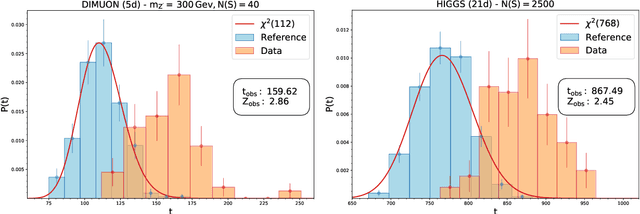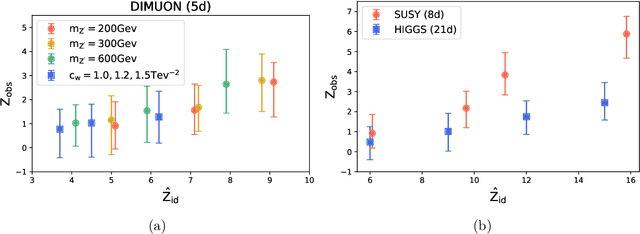Andrea Wulzer
Goodness of fit by Neyman-Pearson testing
May 23, 2023



Abstract:The Neyman-Pearson strategy for hypothesis testing can be employed for goodness of fit if the alternative hypothesis $\rm H_1$ is generic enough not to introduce a significant bias while at the same time avoiding overfitting. A practical implementation of this idea (dubbed NPLM) has been developed in the context of high energy physics, targeting the detection in collider data of new physical effects not foreseen by the Standard Model. In this paper we initiate a comparison of this methodology with other approaches to goodness of fit, and in particular with classifier-based strategies that share strong similarities with NPLM. NPLM emerges from our comparison as more sensitive to small departures of the data from the expected distribution and not biased towards detecting specific types of anomalies while being blind to others. These features make it more suited for agnostic searches for new physics at collider experiments. Its deployment in other contexts should be investigated.
Fast kernel methods for Data Quality Monitoring as a goodness-of-fit test
Mar 09, 2023Abstract:We here propose a machine learning approach for monitoring particle detectors in real-time. The goal is to assess the compatibility of incoming experimental data with a reference dataset, characterising the data behaviour under normal circumstances, via a likelihood-ratio hypothesis test. The model is based on a modern implementation of kernel methods, nonparametric algorithms that can learn any continuous function given enough data. The resulting approach is efficient and agnostic to the type of anomaly that may be present in the data. Our study demonstrates the effectiveness of this strategy on multivariate data from drift tube chamber muon detectors.
Learning new physics efficiently with nonparametric methods
Apr 05, 2022



Abstract:We present a machine learning approach for model-independent new physics searches. The corresponding algorithm is powered by recent large-scale implementations of kernel methods, nonparametric learning algorithms that can approximate any continuous function given enough data. Based on the original proposal by D'Agnolo and Wulzer (arXiv:1806.02350), the model evaluates the compatibility between experimental data and a reference model, by implementing a hypothesis testing procedure based on the likelihood ratio. Model-independence is enforced by avoiding any prior assumption about the presence or shape of new physics components in the measurements. We show that our approach has dramatic advantages compared to neural network implementations in terms of training times and computational resources, while maintaining comparable performances. In particular, we conduct our tests on higher dimensional datasets, a step forward with respect to previous studies.
 Add to Chrome
Add to Chrome Add to Firefox
Add to Firefox Add to Edge
Add to Edge